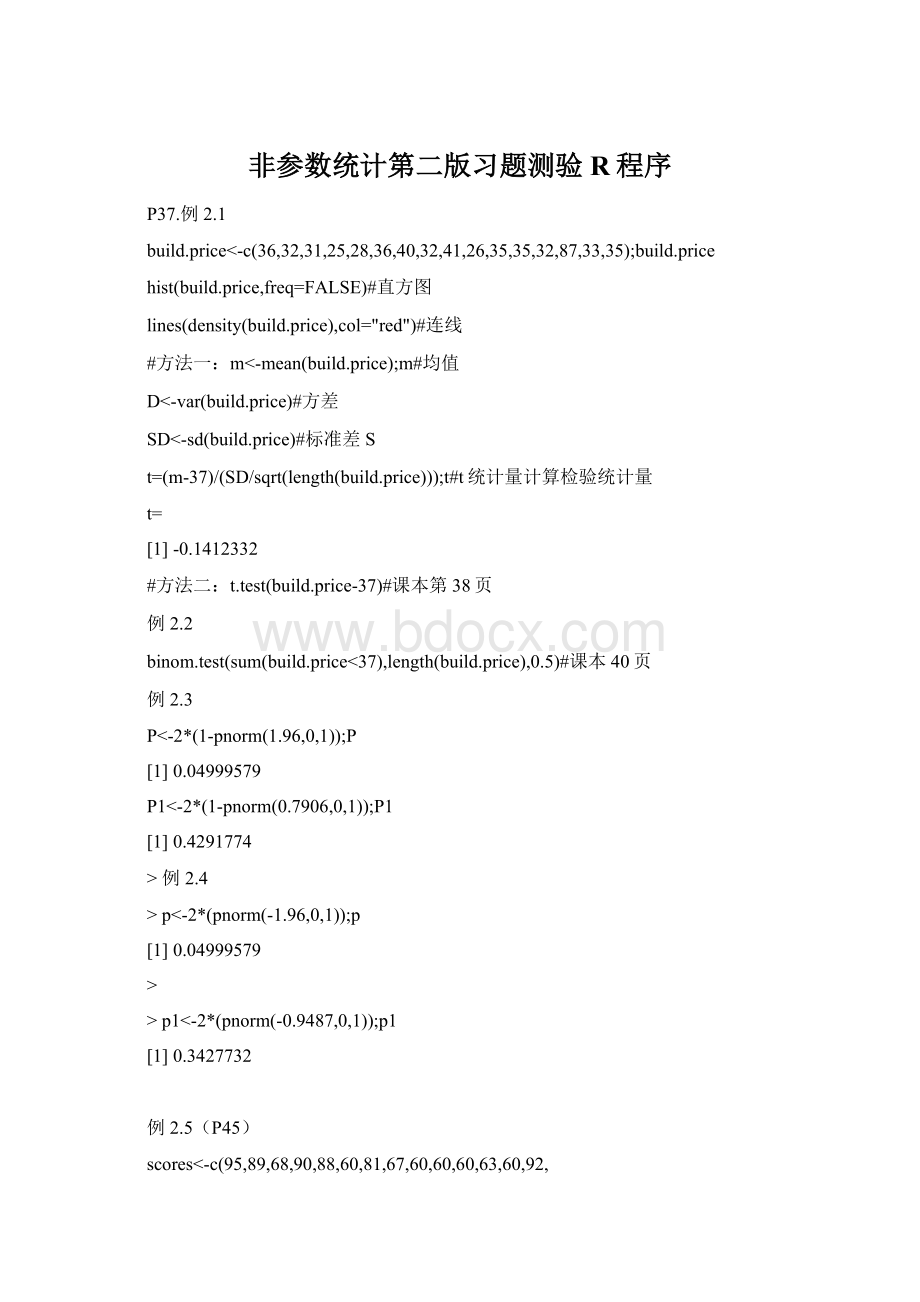非参数统计第二版习题测验R程序Word格式.docx
《非参数统计第二版习题测验R程序Word格式.docx》由会员分享,可在线阅读,更多相关《非参数统计第二版习题测验R程序Word格式.docx(24页珍藏版)》请在冰豆网上搜索。

P
[1]0.04999579
P1<
-2*(1-pnorm(0.7906,0,1));
P1
[1]0.4291774
>
例2.4
p<
-2*(pnorm(-1.96,0,1));
p
p1<
-2*(pnorm(-0.9487,0,1));
p1
[1]0.3427732
例2.5(P45)
scores<
-c(95,89,68,90,88,60,81,67,60,60,60,63,60,92,
60,88,88,87,60,73,60,97,91,60,83,87,81,90);
length(scores)#输入向量求长度
ss<
-c(scores-80);
ss
t<
-0
t1<
for(iin1:
length(ss)){
if(ss[i]<
0)t<
-t+1#求小于80的个数
elset1<
-t1+1求大于80的个数
}
t;
t1
t;
[1]13
[1]15
binom.test(sum(scores<
80),length(scores),0.75)
p-value=0.001436<
0.01
Cox-Staut趋势存在性检验P47
例2.6
year<
-1971:
2002;
year
length(year)
rain<
-c(206,223,235,264,229,217,188,204,182,230,223,
227,242,238,207,208,216,233,233,274,234,227,221,214,
226,228,235,237,243,240,231,210)
length(rain)
#
(1)该地区前10年降雨量是否变化?
t1=0
for(iin1:
5){
if(rain[i]<
rain[i+5])t1<
-t1+1
k<
-0:
t1-1
sum(dbinom(k,5,0.5))#=0.1875
y<
-6/(2^5);
y#=0.1875
#
(2)该地区前32年降雨量是否变化?
t=0
16){
rain[i+16])t<
-t+1
t
k1<
min(t,16-t)-1
sum(dbinom(k1,16,0.5))#=0.0002593994
pbinom(max(k1),16,0.5)#=0.0002593994
y1<
-(1+16)/(2^16);
y1#=0.0002593994
plot(year,rain)
abline(v=(1971+2002)/2,col=2)
lines(year,rain)
anova(lm(rain~(year)))
随机游程检验(P50)
例2.8
client<
-c("
F"
"
M"
"
);
client
n<
-length(client);
n
n1<
-sum(client=="
n1
n0<
-n-n1;
n0
(length(client)-1)){
if(client[i]==client[i+1])t1<
-t1
R<
-t1+1;
R#=12
#findrejectionregion(不写)
rl<
-1+2*n1*n0/(n1+n0)*(1-1.96/sqrt(n1+n0));
rl
ru<
-2*n1*n0/(n1+n0)*(1+1.96/sqrt(n1+n0));
ru#=15.33476(课本为ru=17)
例2.9
shuju39<
-data.frame(read.table
("
SHUJU39.txt"
header=TRUE));
shuju39
attach(shuju39)
sum.a=0
sum.b=0
sum.c=0
length(id)){
if(pinzhong[i]=="
A"
)sum.a<
-sum.a+chanliang[i]
elseif(pinzhong[i]=="
B"
)sum.b<
-sum.b+chanliang[i]
elsefuhao<
-sum.c<
-sum.c+chanliang[i]
sum.a;
sum.b;
sum.c
ma<
-sum.a/4
mb<
-sum.b/4
mc<
-sum.c/4
ma;
mb;
mc
fuhao<
-rep("
a"
12);
fuhao
&
((chanliang[i]-ma)>
0))fuhao[i]<
-"
+"
((chanliang[i]-mb)>
C"
((chanliang[i]-mc)>
elsefuhao[i]<
#利用上题编程解决检验的随机性
-length(fuhao);
-sum(fuhao=="
(length(fuhao)-1)){
if(fuhao[i]==fuhao[i+1])t1<
R
#findrejectionregion
ru
例2.10(P52)library(quadprog)#不存在叫‘quadprog’这个名字的程辑包
library(zoo)#不存在叫‘zoo’这个名字的程辑包
library(tseries)#不存在叫‘tseries’这个名字的程辑包
run1=factor(c(1,1,1,0,rep(1,7),0,1,1,0,0,rep(1,6),0,rep(1,4),
0,rep(1,5),rep(0,4),rep(1,13)));
run1
y=factor(run1)
runs.test(y)#错误:
没有"
runs.test"
这个函数
Wilcoxon符号秩检验
W+在零假设下的精确分布
#下面的函数dwilxonfun用来计算W+分布密度函数,
即P(W+=x)的一个参考程序!
dwilxonfun=function(N){
a=c(1,1)#whenn=1frequencyofW+=1oro
n=1
pp=NULL#distributeofallsizefrom2toN
aa=NULL#frequencyofallsizefrom2toN
for(iin2:
N){
t=c(rep(0,i),a)
a=c(a,rep(0,i))+t
p=a/(2^i)#densityofWilcoxdistributwhensize=N
}
p
N=19#samplesizeofexpecteddistributionofW+
-dwilxonfun(N);
y
#计算P(W+=x)中的x取值的R参考程序!
!
a
length(y)-1
hist(y,freq=FALSE)
lines(density(y),col="
)
例2.12(P59)
ceo<
-c(310,350,370,377,389,400,415,425,440,295,
325,296,250,340,298,365,375,360,385);
length(ceo)
#方法一
wilcox.test(ceo-320)
#方法二
ceo.num<
-sum(ceo>
320);
ceo.num
n=length(ceo)
binom.test(ceo.num,n,0.5)
例2.13(P61)
a<
-c(62,70,74,75,77,80,83,85,88)
walsh<
-NULL
(length(a)-1)){
for(jin(i+1):
length(a)){
walsh<
-c(walsh,(a[i]+a[j])/2)
walsh=c(walsh,a)
NW=length(walsh);
NW
median(walsh)
2.5单组数据的位置参数置信区间估计(P61)
例2.14‘
stu<
-c(82,53,70,73,103,71,69,
80,54,38,87,91,62,75,65,77);
stu
alpha=0.05
rstu<
-sort(stu);
rstu
conff<
-NULL;
conff
n=length(stu);
(n-1)){
n){
conf=pbinom(j,n,0.5)-pbinom(i,n,0.5)
if(conf>
1-alpha){conff<
-c(conff,i,j,conf)}
length(conff)
min<
-103-38;
min
c<
-seq(1,(length(conff)-1),3);